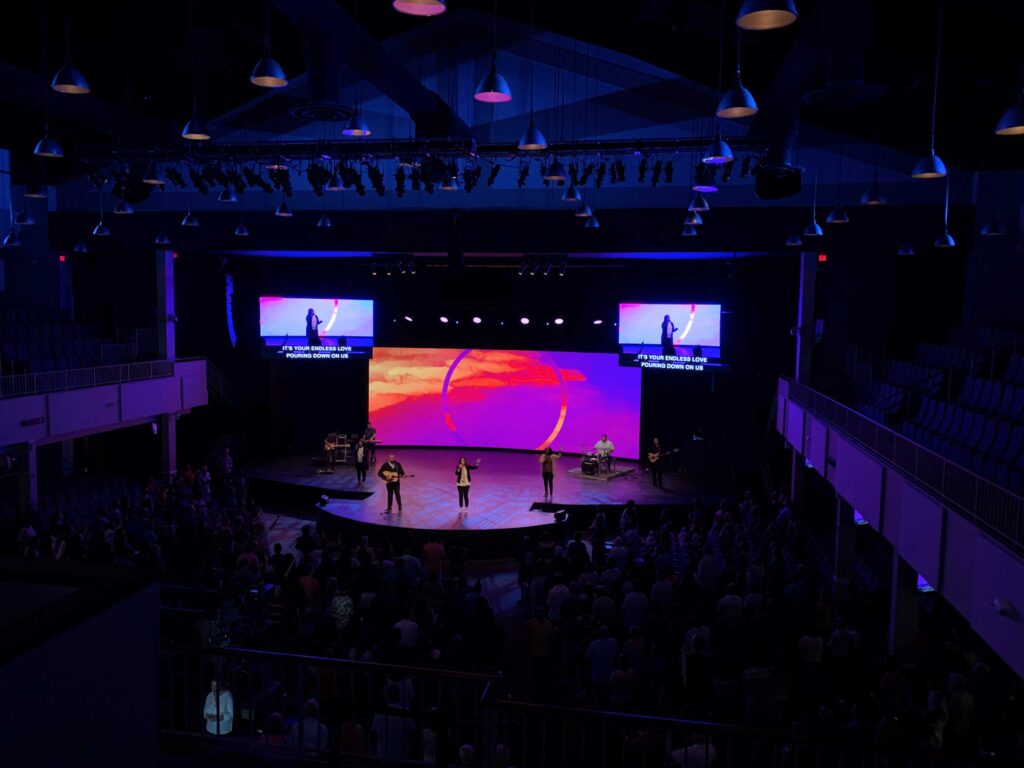Modern Church AV Solutions: An Overview

AV technology has revolutionized how worship services are conducted. It’s hard to imagine a modern house of worship without numerous AV solutions that help augment the overall experience.
From this article, you will learn about the equipment used in houses of worship to connect better with their congregations.
Microphones
Microphones are the foundation of any church AV system. Their primary function is to ensure sermons and prayers are audible to everyone, regardless of the church’s size.
- Dynamic handheld microphones are robust, suitable for both speaking and singing while handling high sound pressure levels.
- Condenser microphones, typically used as overhead devices, excel at capturing choir performances due to their high sensitivity.
- Lavalier microphones are compact clip-on or behind-the-ear devices that are unintrusive and perfect for pastors delivering sermons, especially those who like to move around while they speak.
- Wireless microphones, both handheld and lavalier types, also offer greater freedom of movement.
Soundboards
Mixing consoles or soundboards are vital for managing and controlling the audio output from all microphones, musical instruments, and audio playback devices.
With their help, you can balance the different audio inputs, apply equalization and effects, and direct the audio to different outputs.
Smaller churches with fewer microphones might only need a simple analog mixer. At the same time, larger houses of worship with a band and choir may require a more advanced digital mixer with numerous inputs and digital signal processing (DSP) capabilities.
Speakers and PA Systems
Speakers and public address systems are designed to amplify and distribute sound across the church. The choice of speakers depends on the size and acoustics of the space.
For instance, line array systems suit larger churches with high ceilings, while smaller churches might opt for point source speakers.
A conventional 2-speaker PA system might suffice for a small chapel, but a larger house of worship might require a line array system for more even sound coverage.
Subwoofers can enhance the lower frequencies, which is crucial for music-intensive services. On-stage monitor speakers allow performers to hear themselves.
Acoustic Treatment
An often-overlooked aspect of a church’s AV setup, acoustic treatment helps to control sound reflection, absorption, and diffusion. It improves the clarity and quality of both the spoken word and music by reducing echo, reverberation, and background noise.
This is especially important in larger rooms and halls where there are a lot of hard surfaces that reverberate sound.
For example, large rooms with concrete or stone floors and brick walls can be echo chambers. Acoustic treatment can help a great deal to mitigate this ambient echo.
Projectors and Screens
Projectors and screens can enhance the worship experience by displaying song lyrics, scriptures, or multimedia presentations.
They range from lower-lumen units suitable for darker rooms to high-lumen projectors for brighter spaces. Screens can be fixed or retractable, depending on the church’s spatial and aesthetic considerations.
Video Cameras
Video cameras extend the church’s reach by allowing for the recording and live streaming of services. They can connect the church to home-bound members, those traveling, or individuals who can’t attend in person. Cameras vary from single stationary units to multi-camera setups for different angles and close-ups.
One example of a popular solution for churches is PTZ (Pan-Tilt-Zoom) cameras. They can be remotely controlled to pan (move left or right), tilt (move up or down), and zoom in or out.
They are ideal for houses of worship with limited video personnel, as one operator can control multiple PTZ cameras. They can be installed in permanent locations and controlled from the video booth, making them less intrusive during services.
Video Mixers
Video mixers become essential when working with multiple video sources. They allow switching between different camera feeds, adding transitions, and even overlaying text or graphics.
This ensures a professional and seamless viewing experience for churches with online streams or broadcasts.
Lighting Systems
Lighting can dramatically affect the mood and atmosphere during worship. From spotlights on the pastor during a sermon to colored lights during a song service, lighting systems contribute significantly to the overall worship experience.
Basic setups may use manually controlled lights, while more complex arrangements can involve programmable lighting consoles for automated sequences and effects.
Assistive Listening Systems
For congregants with hearing impairments, assistive listening systems can be invaluable. They transmit audio directly to a receiver used by the individual, improving sound clarity and volume for them.
Assistive listening systems consist of a transmitter connected to the sound system and receivers with headphones for the users. They can use different wireless technologies like FM, infrared, or Wi-Fi.
Building an Ideal Church AV System
As you can see, a well-equipped church AV system is a symphony of various technologies that work together to create a powerful and immersive worship experience. At the same time, it’s easy to get lost in a wealth of options when considering an AV setup for a church.
At Audio-Video Group, we have a long history of helping houses of worship pick the best AV solutions to cover all their needs.
So, whether you’re building your AV setup from the ground up or looking to step up your existing system, we’re here to help. Call us, and let’s talk!

